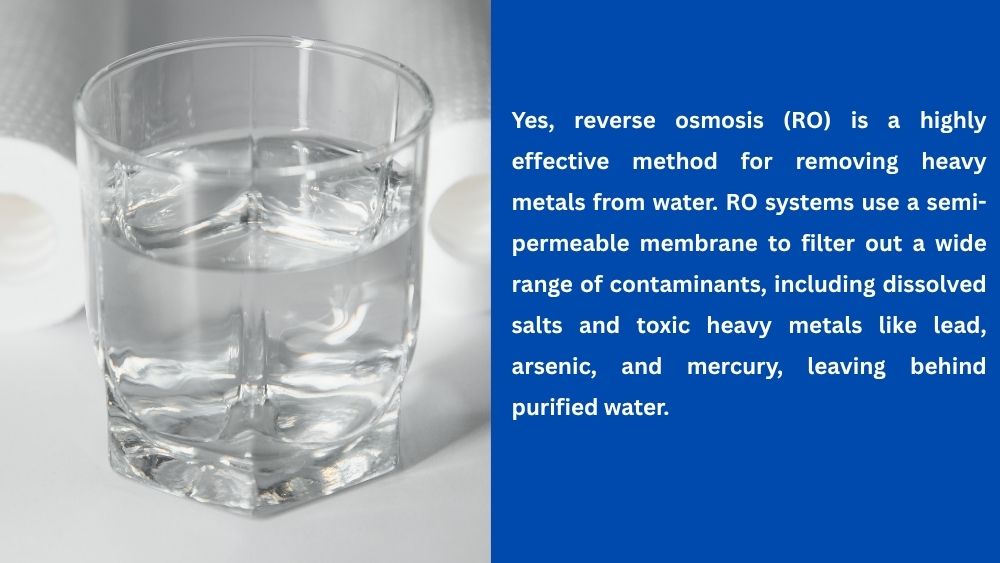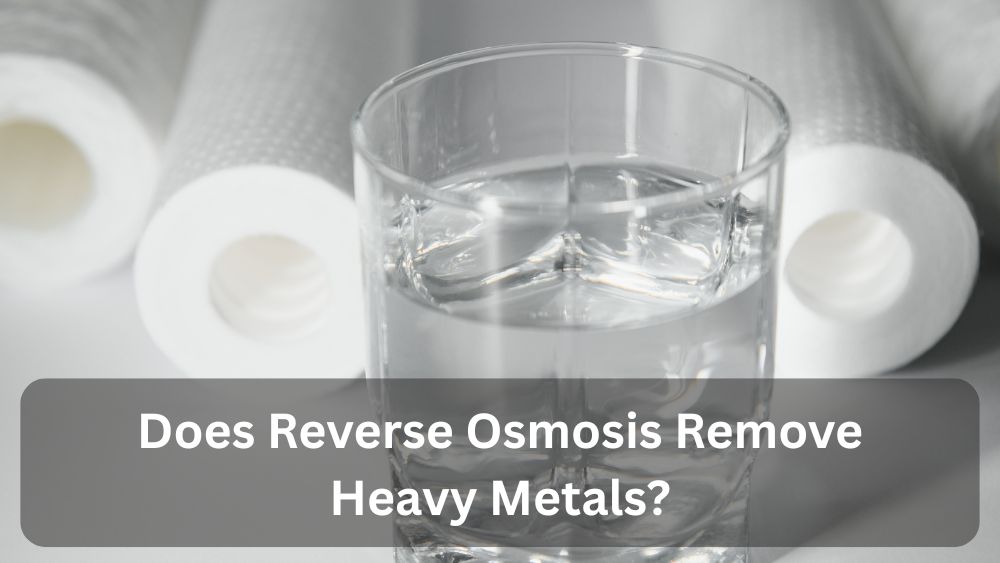Heavy metals in drinking water can silently impact your health for years. Contaminants like lead, arsenic, mercury, and cadmium enter the water supply through old pipes, industrial runoff, or natural deposits in the ground. While most municipal systems filter water before distribution, trace levels of heavy metals often remain. This is why homeowners frequently turn to reverse osmosis (RO) systems.
But does reverse osmosis really remove heavy metals effectively? The answer is yes. A properly functioning RO system removes more than 95–99% of heavy metals, making it one of the most efficient purification technologies available for home and commercial use. In this article, we will explain how it works, what metals it targets, and why maintenance matters for long-term performance.
Key Takeaways
- Reverse osmosis removes 95–99% of heavy metals like lead, arsenic, mercury, and cadmium.
- The semi-permeable membrane blocks metal ions while allowing only pure water molecules to pass.
- Effectiveness depends on membrane quality, pressure, and filter maintenance.
- RO water is safer to drink but may require re-mineralization for taste and health balance.
- Regular servicing ensures consistent removal efficiency over time.
Understanding Heavy Metals in Drinking Water
Heavy metals are naturally occurring elements with high atomic weights and densities. Some, such as iron and zinc, are beneficial in trace amounts, but others — lead, arsenic, mercury, and cadmium — are toxic even in low concentrations. Prolonged exposure can damage the nervous system, kidneys, and bones.
Sources of contamination include:
- Corrosion of old plumbing lines
- Industrial or mining discharge
- Agricultural runoff containing arsenic compounds
- Erosion of natural deposits
According to the World Health Organization, the presence of heavy metals in drinking water is one of the leading environmental health threats globally (WHO.int).
How Reverse Osmosis Removes Heavy Metals
RO systems work by forcing water under high pressure through a semi-permeable membrane. The membrane’s microscopic pores (about 0.0001 microns) allow only water molecules to pass, while rejecting ions, metals, and dissolved solids.
Each stage in an RO system contributes to heavy-metal reduction:
- Sediment filter – removes large particles such as rust and sand.
- Carbon filter – adsorbs chlorine and volatile organic compounds that could harm the membrane.
- RO membrane – the main barrier that traps heavy metals, salts, and nitrates.
- Post-filter – polishes the water for taste and odor.
This multi-stage process explains why RO is more effective than most filtration technologies. For a breakdown of RO components, see 14 components of an RO water purifier system.
Efficiency of RO in Removing Heavy Metals
The table below summarizes approximate removal rates for key contaminants.
| Heavy Metal | RO Removal Efficiency | Common Health Effects |
|---|---|---|
| Lead | 95–99% | Brain and kidney damage, developmental delays |
| Arsenic | 90–98% | Skin lesions, cancer risk |
| Mercury | 95–97% | Nervous system toxicity |
| Cadmium | 95–99% | Bone and kidney damage |
| Chromium | 90–96% | Liver and reproductive effects |
| Copper | 90–98% | Gastrointestinal distress |
These numbers may vary depending on membrane quality, water pressure, and pre-filtration.

Why Reverse Osmosis Is More Effective Than Other Filters
While activated-carbon filters can remove some heavy metals, they are limited in scope. Ion-exchange filters reduce metals but need frequent regeneration. Reverse osmosis, however, physically separates contaminants at the molecular level.
The EPA’s drinking-water treatment guide confirms that RO is among the most effective technologies for removing dissolved metals and salts (EPA.gov). This makes it a preferred solution in both residential and industrial applications.
The Role of Water Pressure and Maintenance
RO systems rely on consistent pressure to push water through the membrane. Low pressure reduces flow and filtration performance, allowing trace metals to pass through. Regular maintenance, including membrane replacement every 18–24 months, is crucial. For details, see how often should RO membrane be replaced.
Periodic cleaning also prevents scale buildup that can damage the membrane surface. If your system shows reduced flow or quality issues, learn how to troubleshoot your reverse osmosis system.
Do All RO Systems Remove Arsenic
Arsenic removal depends on the type of RO membrane and water chemistry. Arsenic occurs mainly as arsenate (As⁵⁺) and arsenite (As³⁺). The RO process is highly effective against arsenate but less efficient against arsenite unless pre-oxidation converts it to arsenate. This is why many systems include an additional oxidation or activated-carbon stage.
For a deeper look at how this works, see how RO systems remove arsenic from drinking water.
Comparing RO to Other Filtration Technologies
| Filtration Method | Heavy Metal Removal | Notes |
|---|---|---|
| Sediment Filter | Very Low | Removes only visible particles |
| Activated Carbon | Moderate | Effective for chlorine, not metals |
| UV Purification | None | Kills microbes but not metals |
| Ion Exchange | Moderate–High | Works for certain metals, needs regeneration |
| Reverse Osmosis | Very High | Removes nearly all dissolved heavy metals |
As the table shows, RO stands out as the most comprehensive method for removing metals and dissolved salts.
Does RO Remove Essential Minerals Too
Yes, RO removes both harmful and beneficial minerals. This includes calcium, magnesium, and potassium. While this does not pose a direct health hazard for people on balanced diets, some users find the taste of RO water flat or acidic.
To improve taste and restore natural balance, many people add a remineralization stage. You can learn more in best alkaline filter for RO.
Factors That Affect Metal Removal Efficiency
- Water temperature: Warmer water improves flow but can shorten membrane life.
- Pressure: Higher pressure increases filtration efficiency.
- Membrane quality: Certified membranes perform best for heavy-metal removal.
- TDS levels: Extremely high TDS can reduce efficiency over time.
- Maintenance schedule: Dirty filters or fouled membranes lower performance.
For users wanting to optimize efficiency, how to reduce the operating cost of RO systems explains how regular servicing improves both lifespan and water quality.
Health Benefits of Removing Heavy Metals
Eliminating heavy metals from drinking water protects against serious long-term diseases. Children are especially vulnerable to lead and mercury exposure. Adults benefit from reduced risks of kidney and bone damage, better immune health, and lower chances of certain cancers.
According to WHO research, minimizing exposure to metals like arsenic and lead significantly reduces the global burden of chronic disease (WHO.int). Using an RO system is one of the simplest ways to achieve that protection at home.
Environmental Considerations
While RO systems are effective, they also generate reject water. Responsible reuse — such as for cleaning, gardening, or flushing — helps conserve resources. See how to reuse waste water for ideas on sustainable water management.
Modern RO designs minimize waste through better recovery rates and permeate-pump technology. These upgrades save both water and maintenance costs.
FAQs
1. Does reverse osmosis remove all heavy metals completely?
It removes most heavy metals at 95–99% efficiency, including lead, mercury, and cadmium. Small traces may remain if the membrane is old or water pressure is low.
2. Can RO remove arsenic from well water?
Yes, but performance depends on the form of arsenic present. Pre-oxidation enhances removal when arsenite is present.
3. How often should filters be changed to maintain heavy-metal removal?
Pre-filters every 6–12 months and membranes every 18–24 months. Delays in maintenance reduce effectiveness.
4. Does boiling water remove heavy metals instead of RO?
No. Boiling does not remove metals and can even concentrate them as water evaporates. Only filtration methods like RO or ion exchange can reduce metal content.
5. Is RO water healthy to drink daily?
Yes, it is safe and free from toxic metals. However, remineralizing improves taste and ensures a balanced mineral profile.
Conclusion
Reverse osmosis is one of the most effective technologies for removing heavy metals from drinking water. Its membrane filtration process blocks metal ions at the molecular level, ensuring that over 95–99% of lead, arsenic, cadmium, and mercury are eliminated. The key to consistent performance is maintaining good pressure, replacing filters on schedule, and using high-quality membranes.
For most households, an RO system provides peace of mind, protecting families from the long-term health effects of heavy-metal exposure. Combined with regular maintenance and smart reuse of wastewater, it offers both safety and sustainability. For related reading, explore how RO systems remove arsenic from drinking water and does RO kill bacteria and viruses effectively.

Hasan Al Sarker is a Reverse Osmosis Specialist. He has worked for many years to ensure safe drinking water for all. His research paper has been published in several journals, including Issue, Medium, and Slideshare. He is recognized as a water doctor among specialists though he did not attend medical college.
Besides working as a researcher of reverse osmosis technology, he is also very fancy with the kitchen and cooking. His guides are reading thousands of people every day. As a head of content, he is responsible for all the published articles at RO System Reviews.

